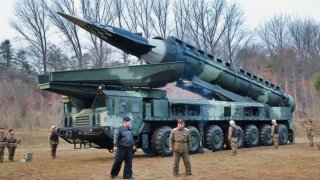The North Korea Hypersonic Missile Threat Is Real
In April, North Korea successfully tested its second solid-fuel, hypersonic, intermediate-range ballistic missile, indicating significant advancements in its military capabilities. This follows an earlier test of a liquid-fuel hypersonic missile in 2021.
Summary: In April, North Korea successfully tested its second solid-fuel, hypersonic, intermediate-range ballistic missile, indicating significant advancements in its military capabilities. This follows an earlier test of a liquid-fuel hypersonic missile in 2021. The new missile features enhanced maneuverability and speed, characteristics that challenge traditional ballistic missile defense (BMD) systems in Northeast Asia. Analysts suggest that this development could lead to a shift in North Korea's missile strategy from liquid-fuel to solid-fuel systems, though the complete phase-out of liquid-fuel missiles is unlikely soon. The test raises concerns about regional security and the need for the U.S. and its allies to bolster BMD efforts. Speculation about North Korea's sudden progress points to potential technical assistance from Russia, linked to Pyongyang's support to Moscow with military systems amid the Ukraine conflict.
North Korea's New Hypersonic Missile Test: A Game Changer for Regional Defense Strategies
U.S. and South Korean military officials confirmed in April that North Korea had conducted its second test of a solid-fuel, hypersonic, intermediate-range ballistic missile. The test appears to have been successful.
The North Koreans already tested a liquid-fuel hypersonic missile in 2021. This is rather advanced technology, but the Russians and Chinese have already used it.
The tests raise several questions. What are the capabilities and differences between this missile and the liquid fuel hypersonic missile the North Koreans tested previously? How will these tests change the way the U.S. and its allies conduct ballistic missile defense (BMD) in Northeast Asia? Perhaps most important, how did the North Koreans suddenly attain this capability?
Growing Hypersonic Capabilities
An examination of the missile tested in April reveals several fascinating elements. The missile is launched from a 14-wheel transporter-erector-launcher. There is what some analysts call a “clamshell” portion near the top of the missile. This device hides and some would say protects the boost-glide vehicle before the missile is launched.
Based on what analysts saw when the test was conducted, it appears this is a legitimate hypersonic missile – or at least a missile with that developing capability. According to The War Zone, “After release, the boost-glide vehicle travels along a relatively shallow atmospheric flight path at hypersonic speeds, generally defined as anything above Mach 5, to its target. The vehicles are also designed to have a significant degree of maneuverability, allowing them to erratically change course and climb and descend along the way.”
If continued testing proves this missile’s capabilities and the North Koreans permanently add it to their inventory, Pyongyang would then wield a liquid-fuel and solid-fuel version of hypersonic missiles. Maneuverability is the key measurement here – the maneuverability of hypersonic missiles is a big part of what makes them a greater threat than typical ballistic platforms.
The advantage of solid-fuel missiles is that they are easier to store and to transport safely. Some analysts expect North Korea will now begin to phase out its liquid-fuel ballistic missiles in favor of using only solid-fuel missiles. That is unlikely, at least for now. North Korea has a very large arsenal of liquid-fuel missiles and will continue to use them.
Threats to Missile Defense in Northeast Asia
A big question for policymakers and military planners is how North Korea’s progress toward solid fuel hypersonic missiles will change ballistic missile defense in Northeast Asia. While the April test was at least partially successful, it also showed that the North Koreans are a ways away from actually being able to produce a highly maneuverable hypersonic missile. Nevertheless, the fact that Pyongyang is now testing both liquid-fuel and solid-fuel hypersonic missiles should shake up BMD efforts in Northeast Asia.
The missile’s range at least in theory allows it to target Japan, all of South Korea, and even Guam. Thus, developing advanced BMD capabilities on the ground and on the seas should now be a high priority for U.S. and allied forces in the region. Increasing focus on shared BMD capabilities should also become a high priority for Washington, Seoul, and Tokyo. Failure to do so could be disastrous if war arrives.
Another very important question is where North Korea got this capability. It is my assessment that there can be little doubt about this. North Korea has been proliferating military systems, ammunition, and even ballistic missiles to the Russians as Moscow prosecutes its war against Ukraine. Most analysts (including myself) assess that the payment for these systems and ammunition has come largely in the form of foodstuffs and oil. But most analysts also assess – as do I – that the Russians have agreed to provide technical military assistance to North Korea. Help with developing more advanced ballistic missiles would be a key part of that.
As the war in Ukraine grinds on, we can expect Russia to continue this kind of support. Advances toward a North Korean solid-fuel hypersonic missile can thus be expected to be rapid.
About the Author
Dr. Bruce E. Bechtol Jr. is a professor of Political Science at Angelo State University. He is also the president of the International Council on Korean Studies and a fellow at the Institute for Corean-American Studies. The author of five books dealing with North Korea, his latest work is entitled North Korean Military Proliferation in the Middle East and Africa.
Image Credit: KCNA Screengrab.


